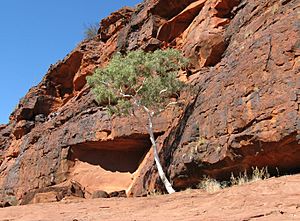Desert white gum facts for kids
Quick facts for kids Desert white gum |
|
|---|---|
 |
|
| Ghost gums in Central Australia. | |
| Scientific classification | |
| Genus: |
Corymbia
|
| Species: |
aparrerinja
|
| Synonyms | |
|
|
The ghost gum (scientific name: Corymbia aparrerinja) is a special type of tree. It grows only in Central Australia. This tree is known for its smooth, pale bark. It has long, thin leaves, white flowers, and fruit shaped like a cup.
Contents
What Does a Ghost Gum Look Like?
The ghost gum is a tree that usually grows up to 20 m (66 ft) (about 65 feet) tall. It often has a special woody swelling at its base called a lignotuber. This helps the tree regrow if it gets damaged.
Its bark is very smooth and can be white, cream, or even pinkish. It often looks powdery. The bark peels off in thin pieces.
Young ghost gum plants have egg-shaped leaves. These leaves are about 50–155 mm (2.0–6.1 in) (2-6 inches) long. They grow in pairs opposite each other.
Older, adult leaves are glossy green on both sides. They are shaped like a spear or are slightly curved. These leaves are about 50–165 mm (2.0–6.5 in) (2-6.5 inches) long. They have a short stalk called a petiole.
Ghost Gum Flowers and Fruit
Ghost gum flowers are white and bloom in summer. The flower buds grow in small groups of three or seven. They are found at the ends of the tree's branches.
Each bud is oval or pear-shaped. It has a rounded cap called an operculum. This cap protects the flower before it opens.
After flowering, the tree produces woody fruits. These fruits are shaped like a cup or a cylinder. They are about 9–13 mm (0.35–0.51 in) (0.35-0.5 inches) long.
How the Ghost Gum Got Its Name
The ghost gum, Corymbia aparrerinja, was officially named in 1995. Two botanists, Ken Hill and Lawrie Johnson, gave it this name.
They studied tree samples collected in 1925 by Herbert Basedow. Another botanist, William Blakely, had also tried to name it earlier. However, his name was not officially accepted at the time.
Where Do Ghost Gums Grow?
Ghost gums live in dry, desert areas of Central Australia. You can find them on rocky hillsides and flat red sand areas. They also grow along dry creek beds.
Their habitat stretches across parts of Western Australia, the southern Northern Territory, and into Queensland. They are very tough trees that can survive in harsh, dry conditions.
Uses of the Ghost Gum
Indigenous Australians have used parts of the ghost gum tree for a long time. They used it as a traditional medicine. For example, some parts of the tree were used to help treat colds.
Cultural Importance of the Ghost Gum
The ghost gum is a very important tree in Australian culture.
Tree of Knowledge
In 1891, a famous ghost gum tree in Barcaldine became very important. It was known as the Tree of Knowledge. Sheep shearers gathered under this tree during a big strike. This event was a key moment in the history of the Australian Labor Party.
Aboriginal Art and Stories
This tree also plays a big role in Aboriginal Dreamtime stories. These are ancient stories that explain how the world was created.
In the 20th century, the ghost gum became famous through art. The well-known Aboriginal artist Albert Namatjira often painted these beautiful trees. His paintings helped many people appreciate the ghost gum.
See also
 In Spanish: Corymbia aparrerinja para niños
In Spanish: Corymbia aparrerinja para niños


